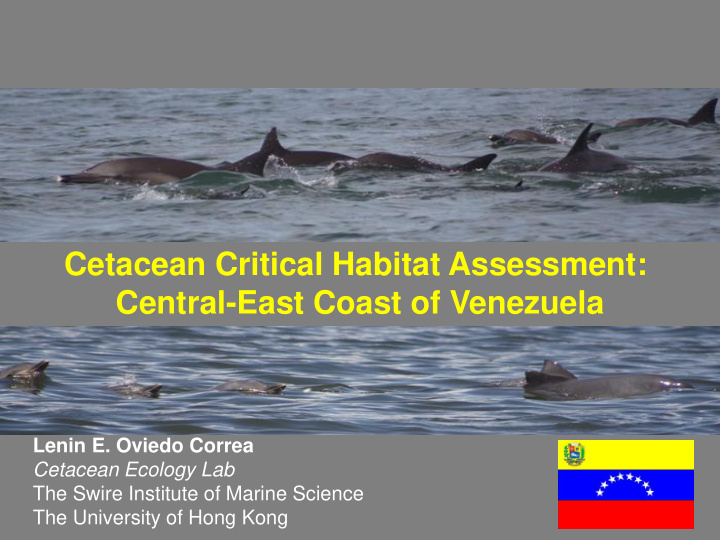



Cetacean Critical Habitat Assessment: Central-East Coast of Venezuela Lenin E. Oviedo Correa Cetacean Ecology Lab The Swire Institute of Marine Science The University of Hong Kong
The Conceptualization of Habitat Habitat is defined as the physical/biological resources and properties of any spatial • location that evoke animal occupancy • The availability of such properties vary across a species range; areas where their availability/density increases can be classified as critical or even unique for the needs of species and populations. • The degree of anthropogenic disruption of natural habitats often corresponds with the area/habitat accessibility and its exposure to human activities, defining the degree of overlap in resource use. • If understood and properly managed, human influence on natural habitats can be converted into management strategies that aim, among others, at long-term wildlife conservation. For group-living animals such as cetaceans, their socio-behavioural responses to • habitat structure may have profound implications on their broader-scale population processes.
Habitat structure influences the energy acquisition and predation risk Predictable Resources Variable Resources Wide-Ranging Communities Resident Communities Small Areas Predator Risk High Predator Risk Reduced Scramble Competition reduced by Cooperative Foraging Scramble Competition: High Large groups Small Group Sizes Intermediate Communities Karczmarski et al 2005; Gowans, Würsig, Karczmarski 2008
Cetacean Habitat Assessment in Venezuela • This contribution reports an assessment and identification of dolphin critical habitats off the central-east coast of Venezuela. • The assessment is done by the means of two complementary approaches at varying geographic scales, a local fine-scale and regional meso-scale, applied to two indicator dolphin species: (a) in-shore Guiana dolphin ( Sotalia guianensis ) and (b) neritic common dolphin ( Delphinus spp).
• Wind induced coastal upwelling processes complemented with the influence of the Orinoco River plume during the second half of the year. Important pelagic fish stock that sustains a high level of coastal development and • one of the richest marine biodiversity in the region. Muller Karger et al 2004. Deep Sea Research II 58: 927-943
North-East Coast as a Model Area for Cetacean Critical Habitat Assessment: Diverse eco-dynamics that promote cetacean diversity • • North-East coast identified as a priority zone for marine conservation Klein et al 2007. Conservation Priorities in Venezuela. In: Chatwin, A. (Ed.). TNC
Data on cetaceans sightings has been gathered since late 90s, however systematic efforts are recent.
Data on cetaceans sightings has been gathered since late 90s, however systematic efforts are recent. Regional (meso) scale Delphinus spp GIS + NNI + Kernel Density Estimate
Data on cetaceans sightings has been gathered since late 90s, however systematic efforts are recent. Local (fine) scale Sotaliaguianensis Regional (meso) scale Delphinus spp Behavior + Spatiotemporal Patterns GIS + NNI + Kernel Density Estimate
Data on cetaceans sightings has been gathered since late 90s, however systematic efforts are recent. Local (fine) scale Sotaliaguianensis Regional (meso) scale Delphinus spp Behavior + Spatiotemporal Patterns GIS + NNI + Kernel Density Estimate Our aim is to identify areas of critical importance to support a healthy • dolphin population as part of an ecosystem based framework that integrates the current level of coastal development. • Rooted in behavioral and spatial ecology, but recognizing the key aspects of the governmental policies and priorities that influence decision making
High Relative Density Areas for Common Dolphin are Neritic (significant non random clumped aggregation pattern; NNI: 0.84, Z score -2.08, p< 0.05). Oviedo et al (2010). JMBA. 90: 1623 -1631
Critical habitats identified by density analyses overlap with equally localized coastal upwelling
An Apparent Spatial Predator-Prey Relationship: distribution of common dolphins vs. local commercial fishery Small pelagics vs. common dolphins in sectors referred by Freon et al. (1997) as key fishing grounds.
Recommend
More recommend